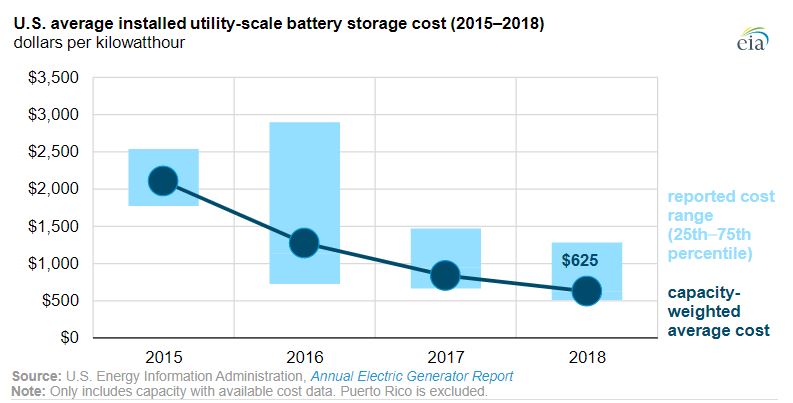During the last three years, the average energy capacity cost of utility-scale battery storage has decreased 70 percent, informed the Energy Information Administration (EIA) last week.
These systems storage electricity produced by generators or pulled directly from the grid; later, they redistribute the energy to where is needed. As the EIA informs, the devices have lowered their cost from $2,152 kilowatt per hour in 2015 to $625 KW per hour in 2018.
As the EIA reports, at the end of 2018, the U.S. had 869 MW of installed battery power and 1.236 MW of battery capacity; the maximum capacity of provided energy by a battery and the maximum energy capacity stored in one, respectively.
According to the report, California had the most installed battery capacity in all the country in 2019. The average cost was $1,522/kWh, and about two-thirds of all the capacity was used in frequency regulations.


Recommended to you: 100% Solar in households could save billions: study
Demand for battery capacity rising
The same happens in the PJM area: “batteries installed in PJM are used for power applications, such as frequency regulation, which helps maintain the grid’s electric frequency on a second-to-second basis. PJM prioritizes power capabilities that use shorter durations over energy use cases that store large amounts of energy over time. For this reason, the power capacity installed cost is a better indicator of the price for value in PJM”, the report says.
The decrease is due to the lowering cost of the materials and the rising in demand. According to the EIA report, the U.S. added about 152 MW of battery capacity in 2019 and an additional 301 MW through July 2020.
More additions are expected based on these data: up to 6,900 MW in the next few years. Additions made by developers and power plant owners also increase the rentability, reliability, and resilience of renewable energy outputs.
This means that solar and wind power are going to be even cheaper as they are now. Earlier this month, the International Energy Agency published its 2020 Energy Outlook. On it, among other conclusions, solar was named as the cheapest energy in all history.
Also, last week EIA reported that renewable energy had a significant increase in its use among the whole U.S. power grid.


